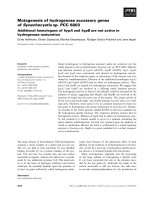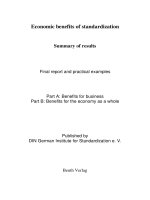Compensations and benefits of jobs are not fixed. They can be changed due to both external and internal factors reasons
Bạn đang xem bản rút gọn của tài liệu. Xem và tải ngay bản đầy đủ của tài liệu tại đây (80.6 KB, 8 trang )
Thesis Statement 3: Compensations and benefits of jobs are not
fixed. They can be changed due to both external and internal
factors reasons
According to the thesis statement, salaries and benefits are not set in stone and may alter
depending on a number of variables, including macroeconomic data and employee performance.
Recognizing that pay and benefits are not static and may be changed by both internal and
external influences, this statement emphasizes the dynamic nature of compensation and benefits
in the workplace.
Macroeconomic indicators are one aspect that may affect pay and benefits. Macroeconomic
factors like inflation rates, economic growth, and market competitiveness may have an impact on
the larger labor market and businesses' capacity to offer specific pay packages. Companies may
have financial difficulties and be unable to provide the same level of perks and compensation
during times of economic hardship or recession. On the other hand, during periods of economic
expansion, businesses may have more money to devote to employee salaries and benefits.
Additionally, how well workers perform may have a big impact on how much they are paid and
what perks they get. Employees that exhibit great performance are often rewarded with increased
pay, bonuses, or other perks under the performance-based compensation schemes that are
prevalent in many firms. The amount of pay and benefits an employee receives is often based on
performance reviews, goal accomplishment, and hitting certain objectives or metrics. This
strategy strives to reward and encourage exceptional achievers while maintaining an equitable
and merit-based system.
In addition to macroeconomic data and employee performance, a variety of other factors may
also affect changes in compensation and benefits. These might include modifications to industry
norms, variations in the demand for certain talents on the market, legal or regulatory
requirements, business financial performance, and staff retention plans. To stay competitive in
attracting and keeping top employees, businesses must regularly assess and modify their pay and
benefits plans.
To guarantee employee happiness and engagement, firms should make an effort to maintain a
fair and transparent approach, even when remuneration and benefits may vary. Clear
communication and well-defined criteria for making compensation adjustments may help to
build trust and reduce potential inequalities or biases in the process.
In conclusion, the thesis statement correctly notes that salaries and benefits are not set in stone
and may vary depending on a number of variables, such as macroeconomic data and worker
performance. For firms to properly manage their incentive systems and satisfy the changing
demands of their workers and the external environment, they must be aware of the dynamic
nature of pay and benefits.
Thesis Statement 4: Employees prioritize the benefits they would
receive from a company over the higher salary job offer.
For a number of reasons, employees value business perks more
than job offers with better salaries. First and foremost, employee
perks provide a better overall experience and raise work satisfaction.
Health insurance, paid time off, retirement savings programs, and
flexible work schedules are just a few of the perks that have a direct
influence on workers' quality of life and work-life balance. In a poll by
the Society for Human Resource Management (SHRM), 61% of
workers said perks increased their happiness at work. Benefits that
allow workers to take part in their hobbies, invest in their health, and
save money for the future may increase morale, engagement, and
productivity at work.
Second, employee benefits may provide long-term stability and
financial security. Although a greater income could provide more
immediate financial satisfaction, perks like retirement savings
programs and all-inclusive health insurance can help workers ensure
their financial future. Employees place a great importance on having
the means to prepare for retirement and safeguard against
unforeseen medical costs, particularly in these unpredictable
economic times.
Employee perks may also show how committed a firm is to the growth
and welfare of its workers. Employers that invest in employee perks
show their employees that they appreciate them beyond financial
remuneration. Employee engagement, motivation, and loyalty may
increase as a result.
Additionally, in a competitive employment market, appealing
perks might help applicants choose between competing job offers.
Employees increasingly look for businesses that provide
comprehensive benefit packages as they understand the value of
work-life balance and overall job satisfaction. Top talent is more likely
to be attracted to and retained by businesses that provide a variety of
appealing advantages. Job seekers are always seeking for positions
with greater income and perks. A Glassdoor poll revealed that almost
60% of participants actively examine the perks and benefits provided
before accepting a job offer. Companies attract applicants more when
they provide competitive compensation and perks.
Overall, choosing employee perks over a job offer with a greater
wage shows the evolving requirements and preferences of workers. It
emphasizes the value of long-term stability, work-life balance, and
overall well-being in today's workforce. With so many employee perks
available, it may be difficult for businesses to provide the best ones
while staying within a certain budget. The demands of their workers
should be understood by HR executives, who should then strategically
determine which benefits would best meet those needs.
Key Issue 2:Google suffers from an unclear system of talent
identification
According to the thesis statement, Google as an organization
has trouble efficiently finding talent because of a murky structure.
Finding talent is a crucial process for businesses, particularly those
looking to attract and keep top workers. The best qualified people for
their staff may be harder for Google to find and grow if they run into
problems in this area.
Multiple possible problems may arise from a method of talent
identification that is ambiguous. First off, it could make it more
difficult to define the precise requirements and credentials needed for
different tasks inside the firm. Without defined criteria, it may be
difficult to evaluate and pinpoint people who have the abilities,
knowledge, and potential to perform in certain roles.
Second, inconsistent assessment and selection procedures may
result from an unclear talent identification strategy. Different
managers or departments may use different strategies or subjective
techniques to find talent, which might result in prejudice or
inconsistent decision-making. Employees may feel unfairly treated as
a result, and their confidence in the company's talent management
procedures may decline.
Furthermore, a hazy talent identification method might make it
more difficult for the company to proactively find and nurture highpotential employees. Without a well defined procedure, it becomes
difficult to identify emerging talent or provide workers with
extraordinary qualities or potential targeted growth opportunities. As
a consequence, the firm may lose out on growth possibilities and have
a less efficient talent pipeline.
Google should think about putting in place a more organized
and open talent identification method to solve these issues. This might
include setting uniform assessment standards, outlining the abilities,
talents, and attributes required for success in different jobs, as well as
offering managers engaged in the talent identification process
training and direction. A further way to enhance objectivity and
impartiality in the talent identification process is by using data-driven
methodologies, such as performance measurements, evaluations, and
talent analytics.
The talent identification method has to be evaluated and
improved on a regular basis to be successful. This might include
getting input from supervisors, workers, and other stakeholders. It
can also entail keeping an eye on the performance and success of
recognized talent inside the company.
In conclusion, a murky talent identification mechanism may
make it difficult for Google to find and develop elite people. Google
may improve its capacity to recognize and nurture people with the
abilities and potential required for success inside the business by
putting into place a systematic and open approach.
Coffee is an amazing drink that wakes you up and makes
you feel good. It smells really nice and tastes delicious. When
you drink it, you feel warm inside and it gives you energy. It has
different flavors like chocolate and caramel. Coffee is more than
just a drink, it's something that makes you feel happy and helps
you relax. It's great to have when you're alone or when you
want to have a chat with someone. Drinking coffee makes your
day better and gives you a boost. So, enjoy a cup of coffee and
let it bring joy to your day.
The thesis statement suggests that compensations and benefits of jobs are
not fixed and can be subject to changes based on various factors such as
macroeconomic indicators and employees' performance. This statement
highlights the dynamic nature of compensation and benefits in the
workplace, acknowledging that they are not static and can be influenced by
external and internal factors.
One factor that can impact compensations and benefits is macroeconomic
indicators. Macroeconomic conditions, such as inflation rates, economic
growth, and market competitiveness, can influence the overall labor market
and organizations' ability to offer certain compensation packages. In times of
economic downturn or recession, companies may face financial constraints
and be unable to provide the same level of compensations and benefits as
during periods of economic prosperity. Conversely, during times of economic
growth, companies may have more resources to allocate towards employee
compensation and benefits.
Furthermore, employees' performance can also play a significant role in
determining their compensations and benefits. Many organizations have
performance-based reward systems in place, where employees who
demonstrate exceptional performance are often rewarded with higher
salaries, bonuses, or additional benefits. Performance evaluations, goal
achievement, and meeting specific targets or metrics are often used as
criteria to determine the level of compensation and benefits an employee
receives. This approach aims to recognize and incentivize high-performing
individuals while ensuring a fair and merit-based system.
In addition to macroeconomic indicators and employees' performance, other
factors can influence changes in compensations and benefits. These may
include changes in industry standards, shifts in market demand for certain
skills, legal or regulatory requirements, company financial performance, and
employee retention strategies. Companies must continuously evaluate and
adapt their compensation and benefits programs to remain competitive in
attracting and retaining top talent.
It is important to note that while compensations and benefits can be subject
to change, organizations should strive to maintain a fair and transparent
approach to ensure employee satisfaction and engagement. Clear
communication and well-defined criteria for determining compensation
adjustments can help foster trust and mitigate potential disparities or biases
in the process.
In conclusion, the thesis statement accurately points out that compensations
and benefits of jobs are not fixed and can be influenced by a range of
factors, including macroeconomic indicators and employees' performance.
Recognizing the dynamic nature of compensation and benefits is crucial for
organizations to effectively manage their reward systems and meet the
evolving needs of their employees and the external environment.









